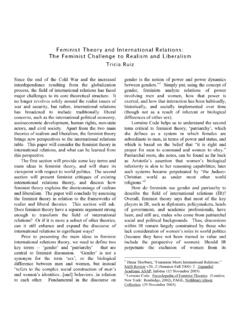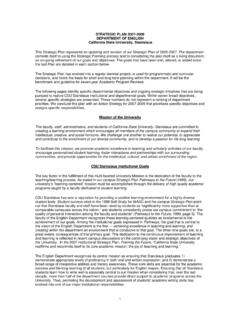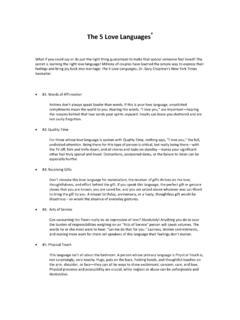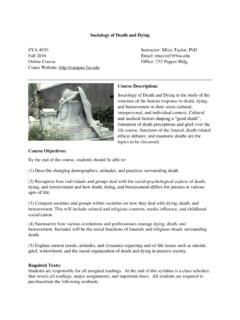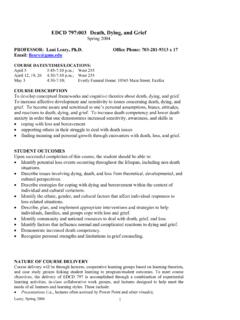Transcription of Death and Dying: Conceptual Characteristics of Grief and ...
1 85 Death and dying : Conceptual Characteristics of Grief and Religiosity in a Hospice Population Edgar Garibay Is there a relationship between our degree of religiosity and how we grieve? Is the level of intrinsic or extrinsic religiosity related to the level of acceptance of loss? Because intrinsic and extrinsic levels of religiosity fall on a continuum, individuals do not fit neatly into a fixed category. Even so, my research suggests a strong positive relationship between intrinsic religiosity and the acceptance of loss. Death . It is a difficult to avoid the universal human experience that a loved one has passed away. At times the personal meaning of Death triggers emotional reactions in the individual (Ciccarelli, 2001).
2 If an individual who has recently lost a loved one associates Death with negative consequences, this can engender various fears or concerns about Death and dying (Ciccarelli, 2001). But if the experience of loss is so common, why do we fear the thought of dying ? There could be endless answers to this question, but often we deny the inevitable during early parts of our life. Often our culture helps buffer us from the initial impact of Death through the use of euphemisms such as passed away, moved on, or departed (Jung, 1934; Wahl, 1958). Wahl (18, 1958) suggests the reason many of us identify with a religion or philosophical system is to help us cope with the reality of a loved one s Death .
3 Religion and philosophical systems often assert the experience of Death is not spiritual Death , allowing us to see Death as a transition from one world to another. Grief . Addressing this question from a psychological perspective, Elisabeth K bler-Ross thinks it is inconceivable for our unconscious to imagine an actual ending of our own life here on In simple terms, in our unconscious mind we can only be killed; it is inconceivable to die of a natural cause of old age. Therefore Death itself is associated with a bad act, a frightening happening, something that in itself calls for retribution and punishment (K bler-Ross, 4, 1999). To some people, Death marks the cessation of a body, while others believe the Death of the body allows for the departure of the soul into an eternal life (Bardis, 1979).
4 Despite these differences in perceptions about Death , we know that one day we will perish from this world. Experiencing the Death of a loved one, on the other hand, is one of the most profoundly difficult experiences that loosely define Grief (Folkman, 1997). Cassarett, Kutner, and Abrahm (218, 2001), defines Grief as, a multifaceted response to loss that includes psychological, behavioral and physical reactions combined with cognitive, emotional, behavioral, social, spiritual and somatic elements. During Grief every system of an individual is assaulted by profound Grief , and thus coping strategies are necessary. That is to say that many people attempt to buffer the effects of loss by turning to their religion for guidance through this process.
5 Other people may search other sources for guidance such as bereavement counseling or talking to others. The focus of the current research is to explore grieving perceptions of individuals who search for religious guidance. Specifically, of those who identify as religious, is there a relationship between the way an individual grieves and his/her approach to religion? Religiosity. The term that psychologist use to describe the role religion plays in the interpretation and response to particular events in a person s life is referred to as religiosity (Hackney & Sanders, 2003). 86 Certain psychologists contend (Allport & Ross 1950, & Jung 1933) that religiosity functions as a source of meaning and stability in an uncertain world and is conducive to positive psychological health (Hackney, et.)
6 Al, 2003, 43). Others do not think that factors of religiosity are conducive to meaning and stability in this world of uncertainty as Jung and Allport stress. This question has long been debated and further researched with different results: some beneficial, neutral, or detrimental. Despite these results, many experts in this field conclude that the religiosity can be best applied as a multidimensional study(Hackney, et. al, 2003). The factors that determine this multidimensional study vary depending upon the definition and measuring dimensions of religiosity (Albrecht, Cunningham, & Pitcher, 2003). The Allport-Ross measures of religious orientation explore the extrinsic-intrinsic dimensions scale.
7 The easiest way to characterize these two dimensions is that extrinsically motivated person uses his religion, while intrinsically motivated person lives his religion (Allport & Ross, 1967). Under this assumption Allport goes on to further define these terms as follows: extrinsic values are instrumental and utilitarian, meaning that these people find their religion useful in many ways, such as: to provide security and solace, sociability and distraction, status and self-justification. Theologically speaking this implies that the extrinsically oriented person turns to God, but without turning away from the self (Allport & Ross, 1967).
8 On the other hand, intrinsically oriented people s sole motive is their religion. Other needs are not as strong as their religious beliefs or devotions. Therefore, their intrinsic values are not utilitarian and it is through this that they live their religion (Allport & Ross, 1967). A clergyman identified the difference between these dimensions best: Some people come to Church to thank God, to acknowledge His glory and to ask for His Others come for what they want to get. Their interest in the Church is to run it or exploit it rather than serve it. (Allport & Ross, 1967) Method Participants. Participants in the study must meet the following requirement: (1) direct family member must have passed away in the last 6 to 12 months and (2) must be at least 18 years of age.
9 Optimal Hospice Care will send a packet in the mail to about 300 potential participants. The packet will contain debriefing forms about the study, a demographic form, and two questionnaires ( Stages of the Grieving Process and Religious Orientation Measures: Allport-Ross Measures of Intrinsic and Extrinsic Characteristics ) and a letter from Optimal Hospice Care informing participants about their support of this study. A self-addressed envelope will be included, and participants who take part in the study will be instructed to send the surveys back to the Honors Program. Design. The Allport-Ross Extrinsic-Intrinsic scale attempts to measure extrinsic and intrinsic tendencies in a person s religious life (Allport & Ross, 1967).
10 This questionnaire divides the extrinsically worded items from the intrinsically. The scale is measured from 1 (the most intrinsic response) to 5 (the most extrinsic response). (Allport- Ross, 1967). The questionnaire on Characteristics of the Grieving Process attempts to measure the level of acceptance in regard to the loss of a loved one. The scale is measured from 1 (the most positive response) to 5 (most negative). Questions were randomly assigned. Questions 2, 4, 6, 8, 10, and 11 that score high under low level of acceptance over the loss will receive a score of 5 and a low score will reflect a score of 1. Reverse coding will be used on the following questions: 1, 3, 5, 7, and 9 in that a high score for the high level of acceptance over the loss will receive a 1 and a low score will receive a 5.

